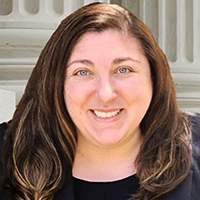
NLD Event Recap: Court Practice Series on Bankruptcy Law

Attorney at Law
Being a bankruptcy attorney was not a decision you needed to make in law school.
“I am an unintentional bankruptcy professional,” said Chief Judge Margaret M. Mann of U.S. Bankruptcy Court, Southern District of California, to the Zoom audience at the NLD’s Court Practice Series on bankruptcy law. “Never even took the class.”
“I too never took a class in bankruptcy,” echoed Gary Rudolph of Sullivan Hill Rez & Engel, who assisted Judge Mann in explaining the nuts and bolts of bankruptcy law at the Oct. 20 webinar for new attorneys.
While a formal bankruptcy class isn’t a necessity, the duo hope you paid attention in Evidence and Civil Procedure classes. They also noted that in San Diego’s largely technology-driven economy, intellectual property assets can play a significant role in bankruptcy proceedings.
Rudolph, whose first job out of law school was at a boutique bankruptcy firm, fell head over heels for the practice with his first case, which concerned a Ponzi scheme.
Judge Mann originally chose bankruptcy practice due to her finance background as well as the congeniality and practicality of the profession.
“Bankruptcy law is very solution-oriented and pragmatic,” she said. “Time is not wasted in pointless battles so people can get on with their lives.”
The Bankruptcy Code is divided into nine chapters. With one exception, these chapters are all odd-numbered. They are chapters 1, 3, 5, 7, 9, 11, 12, 13, and 15.
Chapters 7, 9, 11, 12, and 13 set forth specific rules for certain types of bankruptcy cases. Chapters 7 and 13 mostly concern consumer bankruptcy. Chapter 11 mainly addresses business reorganizations, and chapter 12 affords special benefits to family farmers and family fishermen. Chapter 15 involves cross-border insolvency proceedings. Chapters 1, 3, and 5 lay down general rules affecting the entire bankruptcy system. Related rules and statutes include judges’ chamber rules, Titles 18 and 28 of the United States Code, the California Civil Code, the Federal Rules of Evidence, administrative laws and local district court rules.
The Bankruptcy Code isn’t without its critics, and Judge Mann highlighted a particular point of tension: the reaffirmation agreement. A reaffirmation agreement is a voluntary agreement made between a debtor and creditor that waives discharge of a debt that would otherwise be discharged in the pending bankruptcy proceeding. It might seem counterintuitive that a debtor would voluntarily waive a debt, but, as with most bankruptcy laws, there’s a lot more to it.
“Since the code was written, there have been political battles between debtors and creditors,” Judge Mann explained. “For these kinds of secured debts, usually cars and mobile homes, there’s a lot of pressure that was put into the bankruptcy code in 2005 to give up the discharge.”
In 2005, the Bankruptcy Code was amended vis-à-vis the Bankruptcy Abuse Prevention and Consumer Protection Act (BAPCPA). Notably, the BAPCPA makes Chapter 7 personal bankruptcy more difficult to qualify for, which in turn encourages more Chapter 13 filings.
Sen. Elizabeth Warren is an outspoken critic of BAPCPA, writing in her book The Law of Debtors and Creditors: Text, Cases, and Problems: “Most bankruptcy specialists believe that the basic premise of BAPCPA is wrong (and its name Orwellian), because most debtors who file for bankruptcy do so in the aftermath of a serious economic shock such as a job loss or medical problem, and that a change in the laws will not change the underlying economic realities facing people in serious financial trouble.”
However, the BAPCPA also has its benefits; for example, certain retirement assets such as traditional and Roth IRAs, which previously were not covered by the Bankruptcy Code, now have federal bankruptcy protection.
If you are interested in practicing bankruptcy law, Judge Mann suggests studying practice guides and volunteering with community legal clinics such as the Legal Aid Society clinic.
“Some people think bankruptcy is magic and hard to understand,” Judge Mann said, “but what it really is, is an attempt to fairly balance the interests of debtors and creditors.”
================================================================
FOUR TIPS FOR BANKRUPTCY PRACTICE
- Know everything about your client so there are no surprises down the line.
- If representing a creditor, use a 523 action when trying to have a specific debt excluded from the debtor’s discharge and use a 727 action when trying to have all debts excluded.
- Skip the paper discovery and do a deposition.
- Pre-litigation discovery is permitted so long as it has to do with the assets or financial concerns of the debtor.